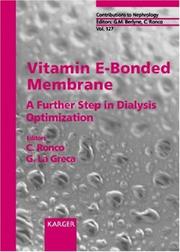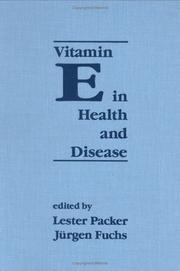| Listing 1 - 10 of 14 | << page >> |
Sort by
|

ISBN: 089766535X 0897665368 Year: 1989 Volume: 570 Publisher: New York, NY : New York Academy of Sciences,
Abstract | Keywords | Export | Availability | Bookmark
 Loading...
Loading...Choose an application
- Reference Manager
- EndNote
- RefWorks (Direct export to RefWorks)
Vitamin E --- VITAMIN E --- Health aspects --- Congresses. --- Physiological effect --- congresses. --- Vitamin e --- Congresses --- Therapeutic use
Book
ISBN: 1851667547 Year: 1992 Publisher: London New York Elsevier Applied Science
Abstract | Keywords | Export | Availability | Bookmark
 Loading...
Loading...Choose an application
- Reference Manager
- EndNote
- RefWorks (Direct export to RefWorks)
Vitamin E --- Analysis --- Derivatives --- Analysis. --- Vitamin E - Analysis. --- Vitamin E - Derivatives - Analysis.

ISBN: 3318004545 3805569068 9783805569064 9783805569064 Year: 1999 Publisher: Basel: Karger,
Abstract | Keywords | Export | Availability | Bookmark
 Loading...
Loading...Choose an application
- Reference Manager
- EndNote
- RefWorks (Direct export to RefWorks)
In recent years, major concerns have been expressed about long-term derangements in hemodialysis patients and possible clinically relevant blood-membrane interactions. Preliminary studies employing biocompatible membranes and antioxidant agents such as vitamin E have demonstrated significant improvements in patient organ function and hemopoietic capacity with increased hematocrit and quality of life. Using a new technology, vitamin E has now been successfully bound to the inner surface of a hollow-fiber membrane, so that the patient's blood is flowing in contact with a layer of antioxidant agent covering the inner surface of the membrane in the hemodialyzer. The opening chapters of this publication give an overview on oxidant stress and the role of vitamin E as antioxidant agent and elaborate on technical aspects, hydraulics and permeability characteristics of the membrane in question. The main part is dedicated to the hemocompatibility of the membrane, its effect on erythrocyte morphology and survival and the impact on white cell and platelet function. The metabolic effects and the antioxidant impact of the vitamin E-coated membrane are presented in the last part of the book. Intended as a reference tool for professionals, students and fellows involved in the care of end-stage renal disease patients, it is also hoped that this book serves as a starting point for further speculations and research in the field.
Hemodialysis --- Vitamin E --- Active oxygen --- Membranes (Technology) --- Hemodialysis --- Hemodialysis --- Membranes, Artificial --- Renal Dialysis --- Vitamin E --- Membranes, Artificial

Abstract | Keywords | Export | Availability | Bookmark
 Loading...
Loading...Choose an application
- Reference Manager
- EndNote
- RefWorks (Direct export to RefWorks)
Vitamin E --- -Vitamin E --- -Tocopherol --- Isopentenoids --- Vitamins, Fat-soluble --- therapeutic use. --- -chemistry. --- Therapeutic use. --- Physiological effect. --- Chemistry. --- Pharmacology. --- Pharmacology. Therapy --- Nutritionary hygiene. Diet --- Tocopherol --- Physiological effect --- Therapeutic use --- chemistry --- pharmacology --- therapeutic use --- chemistry. --- pharmacology. --- Vitamin E - Therapeutic use. --- Vitamin E - Physiological effect.
Book
ISBN: 1789842468 178984245X 1838817964 Year: 2018 Publisher: IntechOpen
Abstract | Keywords | Export | Availability | Bookmark
 Loading...
Loading...Choose an application
- Reference Manager
- EndNote
- RefWorks (Direct export to RefWorks)
In this book, Vitamin E in Health and Disease, the chapter by Dr Lisa Schmölz et al., The Hepatic Fate of Vitamin E, includes the hepatic metabolism of vitamin E, its storage, release, distribution, and its effects on the metabolism in great detail, as well as its effect on the prevention of diseases, in addition to its role in anti-aging. The chapter by Dr Rusu Anca Elena reports on the effect of vitamin E in patients with hemodialysis. In a similar manner, the chapter of Drs Rayan Ahmed and Paul W. Sylvester describe g-Tocotrienol, a natural isoform within the vitamin E family of compounds, which displays potent antiproliferative, apoptotic and reversal of epithelial-to-mesenchymal-transition activity against breast cancer, employing treatment doses that have little or no effect on normal cell viability. The chapter by Milka Mileva and Angel S. Galabov describes how vitamin E could be recommended as a reliable agent, indeed as a component in multiorgan flu therapy. Last, Dr Juan José Godina-Nava et al. describe the cytoprotector effect of the 120-Hz electromagnetic fields in early hepatocarcinogenesis.
Vitamin E. --- Tocopherol --- Isopentenoids --- Vitamins, Fat-soluble --- Life Sciences --- Vitaminology --- Genetics and Molecular Biology --- Alimentology --- Biochemistry

ISBN: 0444800433 Year: 1978 Publisher: Amsterdam Elsevier
Abstract | Keywords | Export | Availability | Bookmark
 Loading...
Loading...Choose an application
- Reference Manager
- EndNote
- RefWorks (Direct export to RefWorks)
Biomembranes --- Animal biochemistry --- Human biochemistry --- Pathology of the metabolism --- Pharmacology. Therapy --- Vitamin E --- Membranes (Biology) --- Oxygen in the body --- 577.16 --- Body composition --- Anoxemia --- Tocopherol --- Isopentenoids --- Vitamins, Fat-soluble --- Congresses. --- Vitamins. Vitamin-like substances. Vitaminology --- 577.16 Vitamins. Vitamin-like substances. Vitaminology --- Congresses --- Vitamin e

ISBN: 012182201X 0121822001 9780121822002 9780121822019 Year: 1999 Volume: 299-300 Publisher: San Diego Academic press
Abstract | Keywords | Export | Availability | Bookmark
 Loading...
Loading...Choose an application
- Reference Manager
- EndNote
- RefWorks (Direct export to RefWorks)
Antioxidanten --- Antioxidants --- Antioxydantia --- Antioxydants --- Oxidants --- Oxidizers --- Oxidizing agents --- Oxydantia --- Oxydants --- Basic Sciences. Chemistry --- Biochemistry --- Proteins and Enzymes. --- Flavonoids. --- Carotenoids --- Oxidation (biological) --- Polyphenols (nonpolymeric) --- Retinoids --- Thiols --- Vitamin a --- Vitamin e --- OXIDATION (BIOLOGICAL) --- LIPID OXIDATION --- ANTIOXIDANTS (PHARMACEUTICAL) --- PROTEINS --- NUCLEIC ACIDS --- REACTIONS
Book
ISBN: 3030053156 3030053148 Year: 2019 Publisher: Cham : Springer International Publishing : Imprint: Humana,
Abstract | Keywords | Export | Availability | Bookmark
 Loading...
Loading...Choose an application
- Reference Manager
- EndNote
- RefWorks (Direct export to RefWorks)
This comprehensive volume examines the role of vitamin E as an essential micronutrient in human health and its extensive clinical benefits. Sections cover a wide breadth of topics, including vitamin E intake and recommended daily allowance, understanding the biological activities of Vitamin E and observed physiological effects, benefits of vitamin E on upper respiratory infections, cardiovascular disease, age-related macular degeneration, Alzheimer’s disease, and intake safety. The text serves to emphasize the importance of vitamin E in relation to disease prevention as well as to raise awareness of the number of health conditions where an increased intake of vitamin E can be of potential significance. It explores vitamin E in an up-to-date, science based, applicable real-life perspective and offers pragmatic solutions for its safe and personalized use beyond the various methodological and statistical controversies. Intended for the medical and nutritional community, Vitamin E in Human Health will not only be an expansive resource for healthcare professionals, but also makes efforts to stimulate increased support for vitamin E research and further exploration of the safe and efficacious use for this essential micronutrient. .
Vitamin E. --- Tocopherol --- Isopentenoids --- Vitamins, Fat-soluble --- Personal health and hygiene. --- Nutrition. --- Food science. --- Clinical Nutrition. --- Food Science. --- Science --- Alimentation --- Food --- Nutrition --- Health --- Physiology --- Diet --- Dietetics --- Digestion --- Food habits --- Malnutrition --- Health aspects --- Clinical nutrition. --- Nutrition . --- Food—Biotechnology. --- Clinical nutrition --- Diet and disease --- Dietotherapy --- Medical nutrition therapy --- MNT (Medical nutrition therapy) --- Nutrition therapy --- Therapeutics, Physiological --- Therapeutic use
Article

Year: 2004
Abstract | Keywords | Export | Availability | Bookmark
 Loading...
Loading...Choose an application
- Reference Manager
- EndNote
- RefWorks (Direct export to RefWorks)
During aging, reductions in hippocampal neurogenesis are associated with memory decline indicating a causal relationship. Indeed, insulin-like growth factor-1 (IGF-1), a major activator of the extracellular receptor kinase pathway that is central in learning and memory processes, is also a key modulator of hippocampal neurogenesis. Previously, we showed that age-related declines in spatial memory tasks can be improved by antioxidant-rich diets containing blueberries. In this study, to begin to understand the mechanisms responsible for the beneficial effects of blueberries, we assessed changes in hippocampal plasticity parameters such as hippocampal neurogenesis, extracellular receptor kinase activation, and IGF-1 and IGF-1R levels in blueberry-supplemented aged animals. Our results show that all these parameters of hippocampal neuronal plasticity are increased in supplemented animals and aspects such as proliferation, extracellular receptor kinase activation and IGF-1 and IGF-1R levels correlate with improvements in spatial memory. Therefore, cognitive improvements afforded by polyphenolic-rich fruits such as blueberries appear, in part, to be mediated by their effects on hippocampal plasticity
Activation. --- Adult dentate gyrus. --- Aged rats. --- Aging. --- Alzheimers-disease. --- Animal. --- Animals. --- Antioxidants. --- Behavior. --- Cognition. --- Diet. --- Dietary supplementation. --- Environmental enrichment. --- Erk. --- Growth-factor-i. --- Growth. --- Hippocampal neurogenesis. --- Hippocampal. --- Human. --- Igf-1. --- Learning and memory. --- Learning. --- Level. --- Mechanisms. --- Medial prefrontal cortex. --- Memory. --- Modulation. --- Neurogenesis. --- Neuronal signal-transduction. --- Neuronal. --- Parameters. --- Plasticity. --- Rat. --- Rats. --- Receptor. --- Reduction. --- Spatial memory. --- Spatial. --- Task. --- Tasks. --- Time. --- Vitamin-e. --- Water maze.
Book
ISBN: 3039213466 3039213458 Year: 2019 Publisher: MDPI - Multidisciplinary Digital Publishing Institute
Abstract | Keywords | Export | Availability | Bookmark
 Loading...
Loading...Choose an application
- Reference Manager
- EndNote
- RefWorks (Direct export to RefWorks)
The metabolomics approach, defined as the study of all endogenously-produced low-molecular-weight compounds, appeared as a promising strategy to define new cancer biomarkers. Information obtained from metabolomic data can help to highlight disrupted cellular pathways and, consequently, contribute to the development of new-targeted therapies and the optimization of therapeutics. Therefore, metabolomic research may be more clinically translatable than other omics approaches, since metabolites are closely related to the phenotype and the metabolome is sensitive to many factors. Metabolomics seems promising to identify key metabolic pathways characterizing features of pathological and physiological states. Thus, knowing that tumor metabolism markedly differs from the metabolism of normal cells, the use of metabolomics is ideally suited for biomarker research. Some works have already focused on the application of metabolomic approaches to different cancers, namely lung, breast and liver, using urine, exhaled breath and blood. In this Special Issue we contribute to a more complete understanding of cancer disease using metabolomics approaches.
cell transporters --- pharmacodynamics --- cell growth --- in vitro study --- metabolomic signatures --- endometabolome --- lung cancer --- metabolomics --- chemometric methods --- bladder cancer --- mTOR --- metabolite profiling --- metabolic pathways --- hepatocellular carcinoma --- glutamate --- senescence MCF7 --- breath analysis --- bio actives --- biomarker --- gas chromatography–mass spectrometry (GC–MS) --- GC-MS --- lung --- omics --- nutraceuticals --- glutaminase --- metabolism --- acylcarnitines --- Erwinaze --- Kidrolase --- glutathione --- targeted metabolomics --- apoptosis --- SLC1A5 --- essential amino acids --- cancer progression --- ASCT2 --- HR MAS --- alanine --- analytical platforms --- volatile organic compound --- glutaminolysis --- isotope tracing analysis --- asparaginase --- vitamin E --- breast cancer --- prognosis --- early diagnosis --- tocotrienols --- NMR --- prostate cancer --- in vitro --- cancer --- MDA-MB-231
| Listing 1 - 10 of 14 | << page >> |
Sort by
|

 Search
Search Feedback
Feedback About UniCat
About UniCat  Help
Help News
News